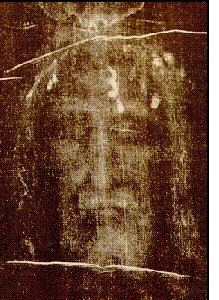ON THE PHYSICAL DEATH OF JESUS CHRISTWilliam D. Edwards, MD; Wesley J. Gabel, MDiv; Floyd E Hosmer, MS, AMI From the Departments of Pathology (Dr. Edwards) and Medical Graphics (Mr. Hoamer), Mayo Clinic, Rochester, Minn.; and the Homestead United Methodist Church, Rochester, Minn., and the West Bethel United Methodist Church, Bethel, Minn. (Pastor Gabel).
(JAMA 1986;255:1455-1463) |
|
| The life and teachings of Jesus of Nazareth have
formed the basis for a major world religion
(Christianity), have appreciably influenced the course of
human history, and, by virtue of a compassionate attitude
towards the sick, also have contributed to the
development of modern medicine. The eminence of Jesus as
a historical figure and the suffering and controversy
associated with his death have stimulated us to
investigate, in an interdisciplinary manner, the
circumstances surrounding his crucifixion. Accordingly,
it is our intent to present not a theological treatise
but rather a medically and historically accurate account
of the physical death of the one called Jesus Christ. SOURCES The source material concerning Christ's death comprises a body of literature and not a physical body or its skeletal remains. Accordingly, the credibility of any discussion of Jesus' death will be determined primarily by the credibility of one's sources. For this review, the source material includes the writings of ancient Christian and non-Christian authors, the writings of modern authors, and the Shroud of Turin. (1-40) Using the legal-historical method of scientific investigation, (27) scholars have established the reliability and accuracy of the ancient manuscripts. (26,27,29,31) The most extensive and detailed descriptions of the life and death of Jesus are to be found in the New Testament gospels of Matthew, Mark, Luke, and John. (1) The other 23 books of the New Testament support but do not expand on the details recorded in the gospels. Contemporary Christian, Jewish, and Roman authors provide additional insight concerning |
the first-century Jewish and Roman legal systems and the details of scourging and crucifixion. (5) Seneca, Livy, Plutarch, and others refer to crucifixion practices in their works. (8,28) Specifically, Jesus (or his crucifixion) is mentioned by the Roman historians Cornelius Tacitus, Pliny the Younger, and Suetonius, by non-Roman historians Thallus and Phlegon, by the satirist Lucian of Samosata, by the Jewish Talmud, and by the Jewish historian Flavius Josephus, although the authenticity of portions of the latter is problematic. (26) The Shroud of Turin is considered by many to represent the actual burial cloth of Jesus, (22) and several publications concerning the medical aspects of his death draw conclusions from this assumption. (5,11) The Shroud of Turin and recent archaeological findings provide valuable information concerning Roman crucifixion practices. (22-24) The interpretations of modern writers, based on a knowledge of science and medicine not available in the first century, may offer additional insight concerning the possible mechanisms of Jesus' death. (2,17) When taken in concert, certain facts -- the extensive and early testimony of both Christian proponents and opponents, and their universal acceptance of Jesus as a true historical figure; the ethic of the gospel writers, and the shortness of the time interval between the events and the extant manuscripts; and the confirmation of the gospel accounts by historians and archaeological findings (26,27) -- ensure a reliable testimony from which a modern medical interpretation of Jesus' death may be made. |
| Holy Week Page | Next Page |
 * Jesus of
Nazareth underwent Jewish and Roman trials, was flogged,
and was sentenced to death by crucifixion. The scourging
produced deep stripelike lacerations and appreciable
blood loss, and it probably set the stage for hypovolemic
shock, as evidenced by the fact that Jesus was too
weakened to carry the crossbar (patibulum) to Golgotha.
At the site of crucifixion, his wrists were nailed to the
patibulum and, after the patibulum was lifted onto the
upright post (stipes), his feet were nailed to the
stipes. The major pathophysiologic effect of crucifixion
was an interference with normal respirations. Accordingly
death resulted primarily from hypovolemic shock and
exhaustion asphyxia. Jesus' death was ensured by the
thrust of a soldier's spear into his side. Modern medical
interpretation of the historical evidence indicate that
Jesus was dead when taken down from the cross.
* Jesus of
Nazareth underwent Jewish and Roman trials, was flogged,
and was sentenced to death by crucifixion. The scourging
produced deep stripelike lacerations and appreciable
blood loss, and it probably set the stage for hypovolemic
shock, as evidenced by the fact that Jesus was too
weakened to carry the crossbar (patibulum) to Golgotha.
At the site of crucifixion, his wrists were nailed to the
patibulum and, after the patibulum was lifted onto the
upright post (stipes), his feet were nailed to the
stipes. The major pathophysiologic effect of crucifixion
was an interference with normal respirations. Accordingly
death resulted primarily from hypovolemic shock and
exhaustion asphyxia. Jesus' death was ensured by the
thrust of a soldier's spear into his side. Modern medical
interpretation of the historical evidence indicate that
Jesus was dead when taken down from the cross.